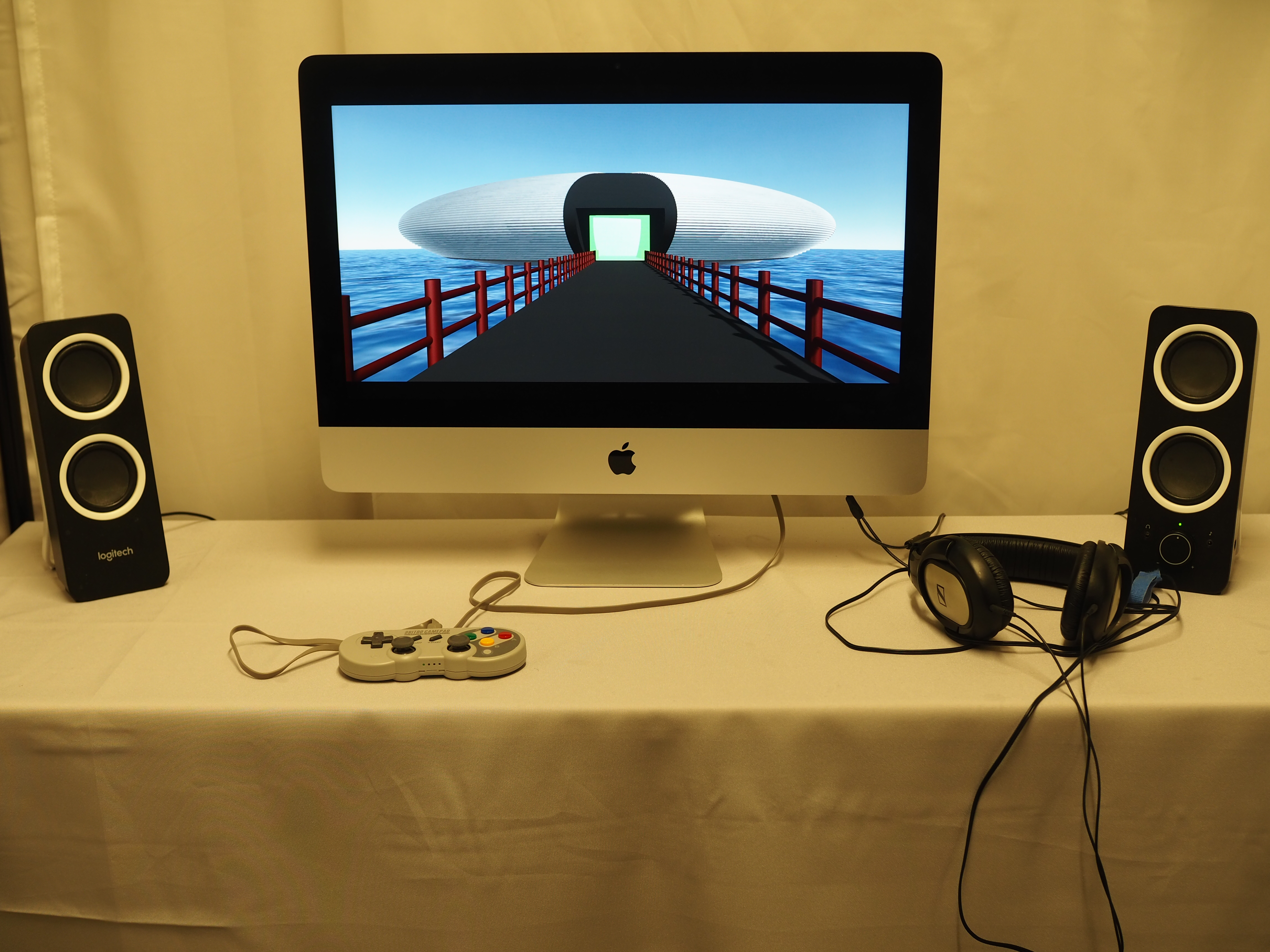Liminal Dream
Liminal Dream is an interactive audio-spatial experience that takes you on a sonic journey as you walk through a virtual space. You're invited to enter the space with the provided game console and explore the interior of a circular building.
produced by: Yewen Jin
Introduction
Liminal Dream is a game that has no end goal. Everything in the environment is contained the one circular building that is also an island on the water, and as you step in it becomes a maze. With a bit of navigation, you’ll find yourself going between a (few) circular corridor(s) and a (few) circular room(s) that all seem to be the similar but with differences in detail. The circularity of the corridor suggests a never-ending path that leads to the same point for potentially infinite times, and its lack of orientation disrupts any sense of judgement for location. As you explore further, you’ll notice that sometimes you’re simply shifted to an alternative corridor when you continue the journey in the same way. Some doors lead to an interior circular room, but not always the same one, and when you exit the room, it’s not always the same corridor that you walked in from.
Throughout the journey, you’ll hear ambient music playing in the background continuously though constantly shifting. In fact, it’s the journey that the player goes through that brings the sonic elements together into a composition. Different layers of sounds get triggered by the player’s location but react to it in different ways. In a way, the audio signals are the best indicators of where exactly one is in the spatial sense, but they are not always noticeable as they melt into similar patterns of repetitive ambient soundtracks.
Concept and Background Research
The Liminal Dream project is an exploration of the concept of Liminal Space. The term liminality was first coined by Anthropologist Arnold van Gennep and developed by Victor Turner in his 1967 essay “Betwixt and Between: The Liminal Period in Rites of Passage”. The term was first used to describe the in between stages in the context of rites in small-scale societies, specifically in the process of “rite of passage”. In a more general context, Liminality refers to a set of qualities that are associated with ambiguity, disorientation and discomfort that occurs in the middle of a transition, where the previous state of condition was put to an end but a new phase has not been defined.
The quality of Liminal Space has inspired a style of aesthetics in films, photography and games, usually represented with images that bring us to places with an atmosphere of nostalgia, loneliness and uncanny. These places evoke an uneasy sense of familiarity through scenes that seem ubiquitous and mundane but empty, lacking people and objects that would normally give us the temporal/spatial/societal contexts, thus appearing as if they were being left behind. One explanation of why these images creates such unsettling emotions is that our brains are constantly seeking contexts for our sense inputs, but when presented with such images and experiences with strong sense of familiarity and the apparent lack of information to make sense from, they fall into a state of anxiety and confusion.
The liminal experience also applies to both the individual and collective experiences in the times of turmoil, where previously held values dissipated but new structures of thoughts are not yet established. This type of anxiety usually forces us to re-examine and reconfigure our value systems and allows for opportunity of rebirth in the malleable state of uncertainty.
The pilot episode of The Twilight Zone from 1959 best illustrated the sense of horror induced by such state of uncertain in-betweenness. The main character found himself in a generic small town where he was the only human to be found, although things seemed to be operated as if there were other people involved: burning cigarette, ringing phone booth, and film playing in the cinema… In the end he went manically searching for company in vain and crashed into a mirror screaming in despair, until he woke up and realized that it was all but a simulation. During the experience he was associating everything around him with the context that he was accustomed to, a society of people, which were terrifyingly absent. This scenario captures the both the aesthetics and psychology of liminal space in an extreme setting.
Technical
The environment is built in Unity and the sound is interactive through OSC communications with Max/Msp. Within Unity Engine, all the scenes share the same backdrop architectural mesh models at the same location but with different details, objects and materials applied. Explicit and implicit portals were used to transport the user between different scenes at different locations, but because of the ambiguity of the place it is hard to tell where exactly the new location is and there is an illusion of continuity in the journey.
In the Max patch, player’s location is received and used as triggers for activating sound samples. The music is originally composed in Ableton Live with a linearly defined structure and multiple instruments and different samples. Afterwards the structure was broken down into different loops from each instrument. Each loop was then exported as a separate sample and categorized into the part it plays in the overall composition, and then, according to its category, became reactive to the distance trigger in a certain way. As the player walks past different points of triggers, some instruments shift into different loops and some ambient sound start to play only when they linger. The spatial exploration disrupts the linear nature a soundtrack, and even though there is a sense of linearity along the path of the corridor, it’s the player that controls the speed and direction of the path, and each time a player walks through the space they recreate the structure of the piece.
Further Development
This version of the game serves as a prototype where the sense of liminality starts to manifest in the process of going through this virtual space and in the way that music was composed. The experience, however, can be much further developed with more layers and content in the scenes. For now, there are 6 main scenes that can be developed into sub-scenes with nuanced differences such as different objects and lightings. To completely get to a finished product, it will involve a narrative or storyline, or a hidden end goal, where this liminality can be exited and come to a resolution.
Self Evaluation
Throughout the exhibition I had the luxury of observing many people experiencing the game space and noticing the variety of responses from them. Overall, it appears that despite a lack of clear goal to the game, most people spent a significant amount of time (by my standard) trying to figure out where this would lead them. Some of them took more time looking around observing the environment and others seemed to be moving faster trying to figure out how it works. I have also noticed that children particularly enjoyed it despite not knowing what they were meant to do, whereas adults tend to give the feedback of having experienced a sense of disorientation and feeling of being trapped. I believe this is a successful prototype that captures the emotions that could be otherwise difficult to articulate and express, although the complexity can be developed much further in the future.
References
- "liminal", Oxford English Dictionary. Ed. J. A. Simpson and E. S. C. Weiner. 2nd ed. Oxford: Clarendon Press, 1989. OED Online Oxford 23, 2007; cf.subliminal.
- Van Gennep, Arnold. The Rites of Passage (London 1977)
- Turner, Victor. "Betwixt and Between: The Liminal Period in Rites de Passage", in The Forest of Symbols (Ithaca, NY: Cornell University Press, 1967).
- Tereszewski, Marcin. “Liminal Space in J. G. Ballard’s ‘Concrete Island.’” Text Matters: A Journal of Literature, Theory and Culture, no. 9 (December 30, 2019): 345–55. https://doi.org/10.18778/2083-2931.09.21.
- Stevens, Robert. Where Is Everybody? Drama, Fantasy, Horror, Mystery, Sci-Fi, Thriller. Cayuga Productions, CBS Television Network, 1959.



































































